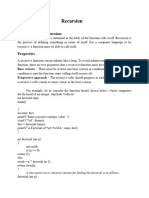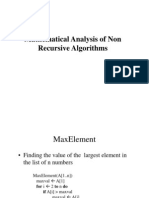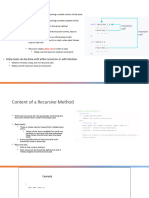0 ratings0% found this document useful (0 votes)
1 viewsAlgorithms_ Recursion Cheatsheet _ Codecademy
Recursion is a problem-solving strategy that involves defining a problem in terms of itself, consisting of a base case to stop recursion and a recursive step to approach the base case. The call stack manages the invocation of recursive functions, and the big-O runtime is determined by the number of recursive calls, which can vary based on the algorithm's complexity. A weak base case can lead to infinite recursion and stack overflow errors.
Uploaded by
خالد بن نقيبCopyright
© © All Rights Reserved
We take content rights seriously. If you suspect this is your content, claim it here.
Available Formats
Download as PDF, TXT or read online on Scribd
0 ratings0% found this document useful (0 votes)
1 viewsAlgorithms_ Recursion Cheatsheet _ Codecademy
Recursion is a problem-solving strategy that involves defining a problem in terms of itself, consisting of a base case to stop recursion and a recursive step to approach the base case. The call stack manages the invocation of recursive functions, and the big-O runtime is determined by the number of recursive calls, which can vary based on the algorithm's complexity. A weak base case can lead to infinite recursion and stack overflow errors.
Uploaded by
خالد بن نقيبCopyright
© © All Rights Reserved
We take content rights seriously. If you suspect this is your content, claim it here.
Available Formats
Download as PDF, TXT or read online on Scribd
You are on page 1/ 3
Cheatsheets / Algorithms
Recursion
Base Case of a Recursive Function
A recursive function should have a base case with a function countdown(value)
condition that stops the function from recursing
if value is negative or zero
indefinitely. In the example, the base case is a condition
evaluating a negative or zero value to be true. print "done"
otherwise if value is greater than zero
print value
call countdown with (value-1)
Recursive Step in Recursive Function
A recursive function should have a recursive step def countdown(value):
which calls the recursive function with some input that
if value <= 0:
brings it closer to its base case. In the example, the
recursive step is the call to countdown() with a print("done")
decremented value. else:
print(value)
countdown(value-1) #recursive step
What is Recursion
Recursion is a strategy for solving problems by defining
the problem in terms of itself. A recursive function
consists of two basic parts: the base case and the
recursive step.
Call Stack in Recursive Function
Programming languages use a facility called a call stack
to manage the invocation of recursive functions. Like a
stack, a call stack for a recursive function calls the last
function in its stack when the base case is met.
Big-O Runtime for Recursive Functions
The big-O runtime for a recursive function is equivalent
to the number of recursive function calls. This value
varies depending on the complexity of the algorithm of
the recursive function. For example, a recursive
function of input N that is called N times will have a
runtime of O(N). On the other hand, a recursive
function of input N that calls itself twice per function
may have a runtime of O(2^N).
Weak Base Case in Recursive Function
A recursive function with a weak base case will not have
a condition that will stop the function from recursing,
causing the function to run indefinitely. When this
happens, the call stack will overflow and the program
will generate a stack overflow error.
Execution Context of a Recursive Function
An execution context of a recursive function is the set
of arguments to the recursive function call.
Programming languages use execution contexts to
manage recursive functions.
Print Share
You might also like
- Prof. S.M. Lee Department of Computer ScienceNo ratings yetProf. S.M. Lee Department of Computer Science61 pages
- Recursionexaplanation of Recursion Very Much ImportantNo ratings yetRecursionexaplanation of Recursion Very Much Important6 pages
- P4 Sec 19.2) Recursion: Syllabus ContentNo ratings yetP4 Sec 19.2) Recursion: Syllabus Content7 pages
- Recursion: CS 367 - Introduction To Data StructuresNo ratings yetRecursion: CS 367 - Introduction To Data Structures20 pages
- Introduction To Data Structure - RecursionNo ratings yetIntroduction To Data Structure - Recursion31 pages
- Military Crypt Analysis by Sreekanth Chaladi50% (2)Military Crypt Analysis by Sreekanth Chaladi649 pages
- Process-Insights MBW 373 Datasheet v22-1No ratings yetProcess-Insights MBW 373 Datasheet v22-17 pages
- Gujarat Technological University: Subject Code:2141004 Subject Name:Control System Engineering Time:10:30 AM To 01:00 PMNo ratings yetGujarat Technological University: Subject Code:2141004 Subject Name:Control System Engineering Time:10:30 AM To 01:00 PM3 pages
- The Characteristics of Pontian Peat Under Dynamic Loading: January 2015No ratings yetThe Characteristics of Pontian Peat Under Dynamic Loading: January 20158 pages
- BRANZ SR120a - Soil - Expansivity - in - The - Auckland - Region - Final - ReportNo ratings yetBRANZ SR120a - Soil - Expansivity - in - The - Auckland - Region - Final - Report155 pages
- INFO 6066 - Intro To Java Data Types and Creating Java ProgramsNo ratings yetINFO 6066 - Intro To Java Data Types and Creating Java Programs22 pages
- English - Yr 8 - Unit 2 - Resource - Al Capsella - Essay PlanNo ratings yetEnglish - Yr 8 - Unit 2 - Resource - Al Capsella - Essay Plan2 pages
- Problem Sheet For Ferromagnetic ActuatorsNo ratings yetProblem Sheet For Ferromagnetic Actuators5 pages
- Being: A Study in Ontology Peter Van Inwagen all chapter instant download100% (6)Being: A Study in Ontology Peter Van Inwagen all chapter instant download66 pages
- Class 11 Physics Project Laws of MotionNo ratings yetClass 11 Physics Project Laws of Motion14 pages
- 1-Ārambha - 6-Nak Atra - 1-Nak Atra Moon SignsNo ratings yet1-Ārambha - 6-Nak Atra - 1-Nak Atra Moon Signs19 pages

























































































